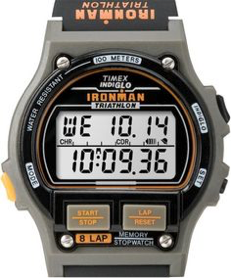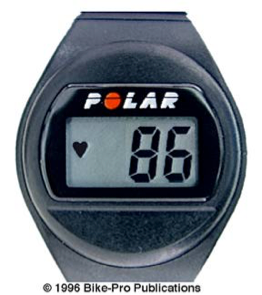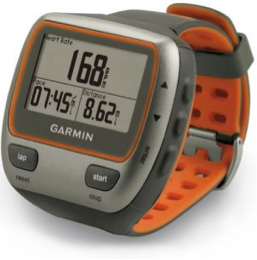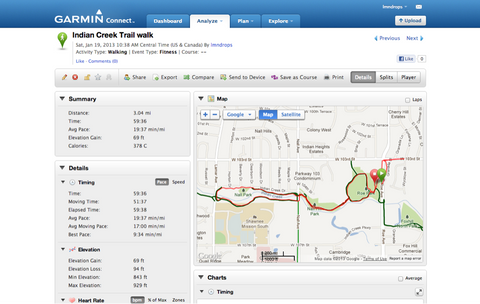- Continue Shopping
- Your Cart is Empty
Wearable Technology for Runners - A Breakdown of GPS Devices
Many people are drawn to running because of its minimalist nature. Shoes and shorts are all that are really needed (a shirt may be added for modesty). But thinkers are often drawn to running, and thinkers like numbers. So where do those numbers come from?
In the old days, runners would usually purchase a running watch, such as a Timex Ironman, that would tell the runner how long they had been running, in addition to what the time and date were. More advanced models could be set to beep at predetermined intervals and record lap times. Here is an early model that could only store 8 laps:

Next, the heart rate monitor was introduced. Number geeks were in heaven! Essentially, a chest strap was worn which transmitted data to a receiver worn on the wrist which was similar to a running watch, but usually a little bigger. Now, runners could train based on physical exertion as determined by the runner’s heart rate, usually as a percentage of maximum heart rate. Of course, interference from electrical lines, crosstalk from your friend’s heart rate monitor, hydration, and illness could all mess with your readings. Here is an early Polar heart rate monitor:

The drawback to the running watch and heart rate monitor as that while it told you how long you had been running, it didn’t tell you how far or how fast. There were a couple of models of running watches which were paired with a footpod which attempted to answer those questions by counting strides and computing speed and distance based on an average stride length, but calibrating them was an inaccurate science and they were fairly bulky and expensive. While a few runners used them, most did not.
Then came a major breakthrough in running technology, the GPS (Global Positioning System) running watch! With a high degree of accuracy, runners could now know speed, distance, pace, and many other measures. Some models also integrated heart rate into their system. The two drawbacks were size and price. Here is a very early Garmin Forerunner GPS watch. Note how that it is so big that it had to be designed sideways!

The next generation of GPS watches was smaller, and more closely resembled a traditional running watch, as in this Garmin Forerunner 305:

As time went on, new features were added, such as an altimeter, compass, etc. Also, new models had functions that could be used on the bicycle, such as cadence and power. This was good news for triathletes. Here is the Garmin Forerunner 310XT, which was also waterproof:

The only real problems were that it was still bulky, didn’t fit small wrists well, and didn’t accurately measure distance in the water. Also, a chest strap was still needed for heart rate date. One particularly smart innovation by Garmin, which definitely supported brand loyalty, was the introduction of Garmin Connect. This is a free website which allows the user to upload all of their training data to a program which tracks activities, training plans, maps, personal records, and a plethora of other information. Here is a screenshot:

The latest innovation in running technology is optical heart rate monitors. Instead of a chest strap, the underside of the watch optically monitors and reports heart rate. The TomTom Multisport Cardio:

Now that you know the history, how do you pick the right wearable technology for you? Here are 4 things to remember when shopping for a GPS watch:
- What should I buy? There is a lot of excellent information on the Internet, particularly in the form of reviews and comparisons. Probably the best site is DC Rainmaker. DC Rainmaker is a techie who likes to write in-depth reviews of the latest products, and even answers questions about them. A particularly handy tool there is his Product Comparison Calculator. You can toggle all of the models you wish to compare and then look at their features side-by-side. One really important consideration for petite women is to purchase a model which will fit snugly on your wrist and not spin around. A good review of 2015 models can be found at com.
- Should I buy new, refurbished, or used? The advantage to buying new is that you are getting the latest technology, get a factory warranty, and have better return options. Also, they will be in perfect condition. Refurbished GPS watches have been restored to as-new condition by the manufacturer, and generally have the same warranty as new. You almost always will save money over buying a new model, but the latest models are usually not available as refurbished. Even the latest models of GPS watches can be purchased used, as sellers may have decided that that model did not have the features they wanted. Beware of ones that are being sold without a charger, especially from pawnshops, as they are frequently stolen and will have no warranty.
- Should I get it with heart rate? This is one of the main questions that needs to be answered when making your purchase, except in the case of models with built in optical heart rate. The heart rate chest strap can add as much as $100 to your purchase, so if tracking your heart rate isn’t important to you, consider going without. Nearly every model allows you to add a heart rate strap later, as the monitoring function is built in. Also, there are generic versions that can be purchased for less. Finally, there are now chest straps specifically designed for swimming and triathlon use.
- Where should I buy it? DC Rainmaker includes links to sites to buy the products he reviews. However, there are usually less expensive options. There are a number of online sites that specialize in GPS watches, and are available for online or telephone consultation. eBay is also an alternative way to buy, including new, refurbished, and used. GPS watches actually hold their value well, so prices are not that far below retail in many cases. Once in a while, a good deal will pop up on Craigslist, but not very often. Finally, if you want to touch it and try it on, your local running specialty store probably has some models to consider.
- What else should you consider? A site like GPS Nation, which is an authorized dealer for most major brands, adds an extra year to the usual one-year warranty when you purchase from them. I have purchased from GPS Nation and have been very satisfied. They also sell factory refurbished models, as well. Another thing to consider is whether or not the model you are purchasing will link with your smartphone. The latest wearable technology can integrate with your iPhone or other such device.
So that brings you up to speed on wearable technology. Check back at StrideTek often for articles on using technology in your training, as well as articles on weight loss, nutrition, training plans, and many other interesting topics!
----------------------------------
Larry LaHodny has a B.S. in Physical Education, with Emphasis in Sports Medicine from Willamette University and an M.B.A. from National University. Larry has over 20 years’ experience coaching runners, including at the youth, high school, and adult level. Larry has trained National Champions, All-Americans, State Champions, and Boston Marathon qualifiers.
